Review: Nokia Lumia 800 - Part 1 - Hardware
As Nokia's first Windows Phone device, it is no surprise that the Lumia 800 is attracting a great deal of attention. It marks a new chapter for the smartphone pioneer and, while it's not a make or break device, it will set the tone for conversations about Nokia for the rest of the year. So what's the device like? What are its key characteristics? In this first part of our in depth review, we look at the Nokia Lumia 800's hardware and, in detail, consider the story behind the device.
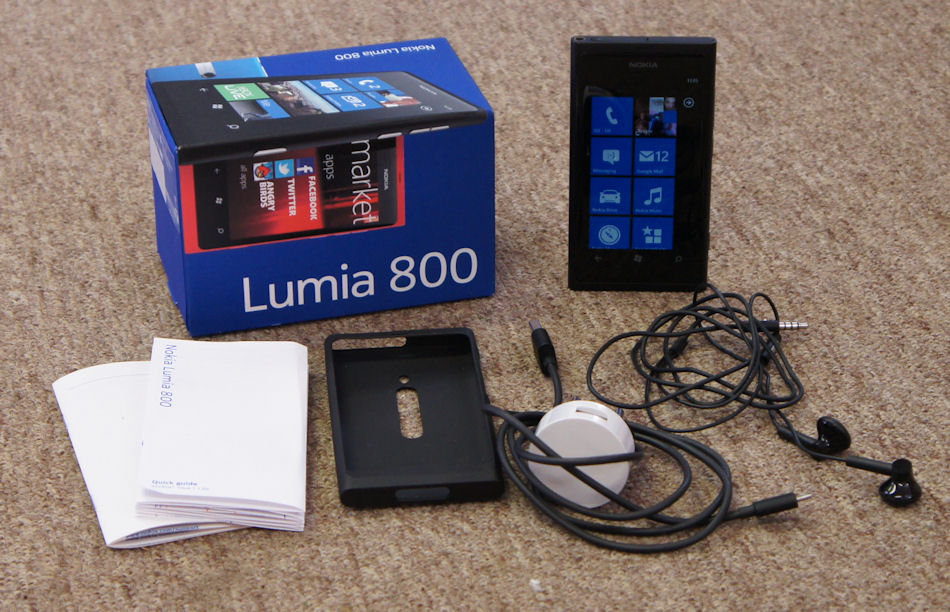
Nokia Lumia 800 and box contents
In the box
The Lumia 800's packaging uses Nokia's new tall, rectangular box style (first seen in the Nokia X7); moving away from the flatter, squarer boxes used previously. With a layered arrangement (from top to bottom: device, documentation, case and other accessories), it is a definite improvement, suggesting just as much care has gone into designing the packaging as the product itself. It's easy to be dismissive of packaging, but, as numerous unboxing videos attest, it has become an important of the initial product experience, helping set the tone for that all important first impression.
The documentation follows Nokia's now standard pattern of an illustrated quick start guide, along with a short product and safety information booklet. The full manual is available online in web and PDF versions. There's no included CD, instead you're pointed, by the quick start guide, to Zune.net (PC) or WindowsPhone.com (Mac) to download the necessary PC software.

Quick start guide
The soft cover case is made from a rubbery material. At 1mm in thickness, it adds very little bulk, but is aimed at protecting against wear and tear, rather than protection serious impacts. Of course, Nokia devices have a reputation for robustness and there's no reason to think the Lumia is an exception - I've already (accidentally) dropped it down a carpeted flight of stairs with no apparent ill effects.
The included Nokia Fast USB Charger (AC-16) is a new style for Nokia (first shipped with the N9), with a small white round (EU / US version) / triangular (UK version) plug, into which a USB to microUSB cable (CA-185CD) is plugged; this same cable is also used for PC connectivity. Wherever possible, it's better to use the supplied AC-16 charger because it allows for faster (2 hours:20 minutes for a full charge) and more efficient charges than standard USB charger.
The supplied headphones (WH-902) are a cut above the average in-box accessory, but, especially for music playback, audio quality can be improved by using any £15+ third party headset. The headset includes a microphone and action button (answer, voice commands), although, in testing, the audio pickup was inferior to using the phone itself or a Bluetooth headset.
Design and materials
The design of the Nokia Lumia 800 is one of its strongest points; in a crowd of touchscreen monoblocks it is instantly recognisable, manages to stand out as something rather special and is the device's most effective piece of differentiation when compared to competing devices.
Nokia says it has used reductionist design principles to simplify the overall design. A first glance reveals a round edged unibody case, accompanied by a curved-at-the-edges piece of glass that covers the screen. The transition from unibody case to glass is near seamless, with no apparent bezel. The real contrast to existing devices is that the curved glass and rounded unibody case gives a continuous form, rather than one with discrete multi-faceted components. It's extremely impressive and really needs to be seen in person to be fully appreciated.
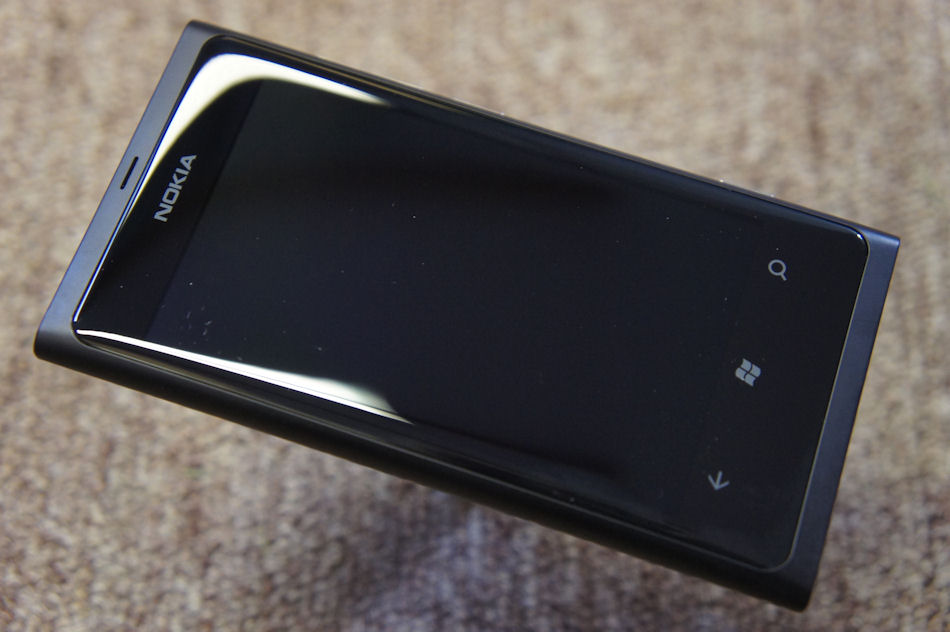
Unibody case with curved ('3D') Corning Gorilla Glass
The unibody shell is made from a single piece of injection moulded polycarbonate. The gaps for the buttons and camera module have been machined out. Polycarbonate is the same material used in motorcycle helmets, big water bottles and bullet proof glass. It's durable and hard wearing, which should mean it stands up very well in day to day use. The colour is integral (not just a layer on top), which means scratches will be less apparent than anodised aluminium or painted plastics. In the hand it has the same warmth as plastics, but the solidity and premium feel of metal; the best of both worlds, in my opinion.
The curved glass is made from Corning Gorilla Glass, which is scratch resistant and is tough enough to withstand most every day drops and bumps. The glass feels slightly smoother than Nokia's other touchscreen smartphones (e.g. N8), suggesting a different (oleophobic?) surface coating has been used. It also seems to be more fingerprint proof and easier to clean, though there's still room for improvement here. The smoother surface works well with the Windows Phone software, which uses a lot of sweeping and scrolling gestures to control the user interface.
The curved glass also gives the perception that the screen, the technical details of which we'll cover in a separate section below, is sitting close to the surface of the device, such that on screen details appears to almost float on top of the glass, a clever design trick.
Just beneath the screen are three capacitive buttons, comprising the standard Windows Phone keys: Back, Start and Find. Using capacitive buttons maintains the sinuous lines of the device, but they don't match the utility of physical buttons. Tapping any of the buttons does generate a feedback buzz from the vibration motor, but it is not localised, making it difficult to distinguish between them by touch alone. In general, the capacitive buttons do not feel quite as well thought out or as organic as the rest of the device's design. Given the design's ancestry that's not a great surprise.
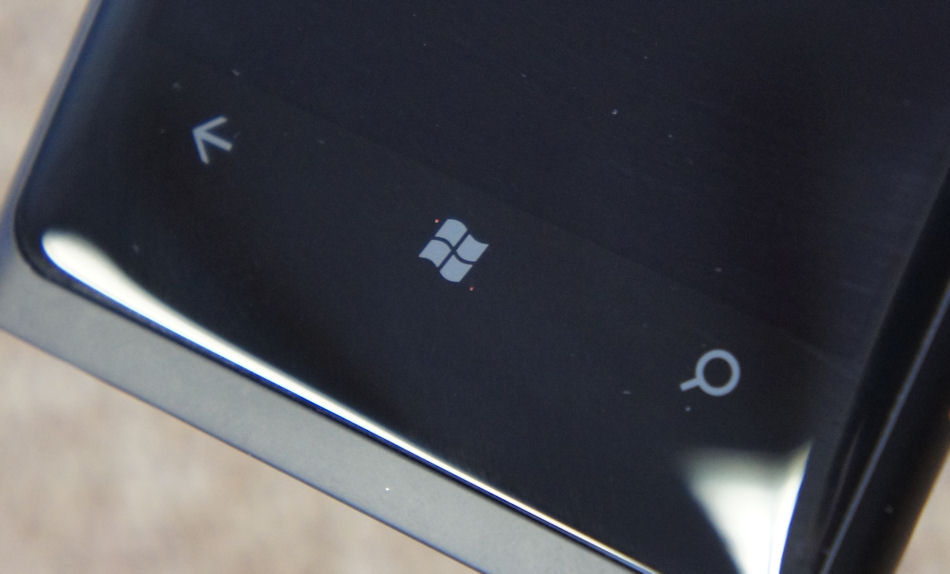
The standard Windows Phone buttons, in capacitive form on the Nokia Lumia 800
On the right-hand-side of the device there are four physical buttons: volume up and down, lock/power and camera capture. The last of these has two stages, one for focusing and one for capturing. These buttons all offer decent tactile feedback, but feel somewhat flimsy in comparison with the rest of design.
The phone's mono speaker is located on the bottom edge of the device; it produces reasonable sound, both in terms of volume and quality. It's certainly good enough for speakerphone usage and quick bursts of music, but has the same limitations as any small speaker. Covering the grille muffles the sound, which can be an issue when while holding the device with both hands in a landscape orientation (e.g. when watching a video).
The 3.5mm audio jack, microUSB port and microSIM card slot are located on the top of the device. The microUSB port is protected by a swing flap, which must be opened to slide out the microSIM caddy on the right hand side - it's a neat, space efficient arrangement. The use of a microSIM is a bit frustrating, but it's something we'll see more of in the future, as a standard SIM and associated components do take up a lot of space. Even if you buy SIM-free, your operator will usually provide a microSIM free of charge.
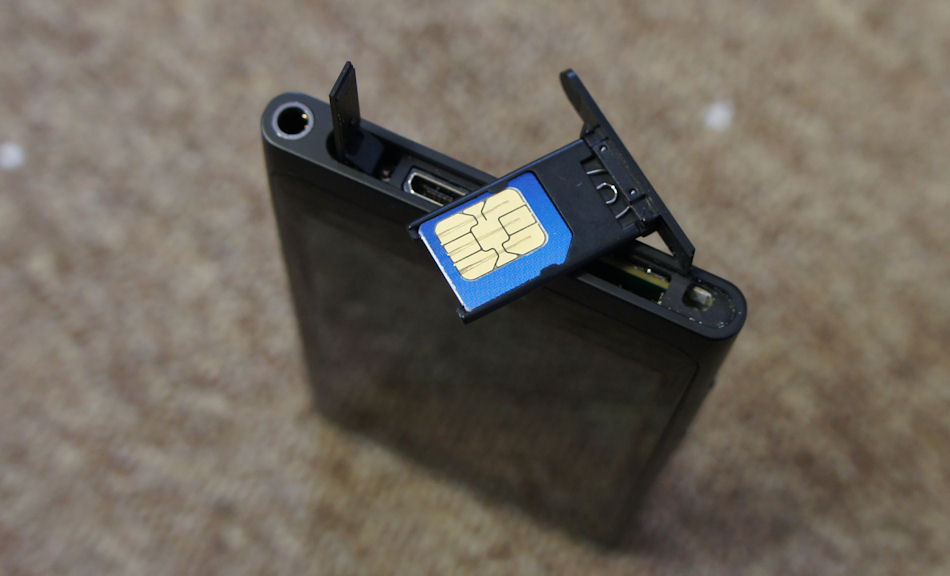
Nokia Lumia 800 microSIM card caddy
On the back of the device, you'll find the 8 megapixel camera, accompanied by a dual LED flash. It's surrounded by a shiny metallic material, which seems to be more susceptible to scratches that the rest of the device; this is where daily wear and tear will be most obvious after a year.
The camera boasts Carl Zeiss Tessar optics with a f2.2 aperture and wide angle sensor. Nokia says the imaging sensor is optimised for both 16:9 and 4:3 images and that the wide angle optics means the camera has up to 60% more 'viewing area' than comparable devices. We'll be looking at the camera and its performance in more detail in a separate part of this review, but suffice to say that while it does not measure up to the Symbian-powered Nokia N8, it is capable of producing excellent results, which put it near the top of the camera phone league tables.

Nokia Lumia 800 from the rear, note the scuff marks on the camera surround
The overall build quality is truly outstanding, the Lumia 800 can only add to Nokia's already strong reputation in this area. Combined with the fresh styling and new materials, it underlines Nokia's status as a design innovator, capable of producing the highest quality mobile device hardware.
Size and weight
At 116.5 x 61.2 x 12.1mm, the Lumia 800's front profile is a little larger than the Nokia N8 (113.5 x 59 x 12.9mm) and the Nokia C7 (117.3 x 56.8 x 10.5mm), but most of this is due to the larger screen (3.7 inches versus 3.5 inches and a wider aspect ratio); it is slightly smaller than the Samsung Omnia 7 (122.4 x 64.2 x 11mm) and the HTC Radar (120.5mm x 61.5mm x 10.9mm).
On paper, the 12.1mm thickness looks a little large compared to other devices, but it is much less apparent when the device is in the hand thanks to the tapered ends, rounded edges and lack of any protrusions. This is reflected in the device's overall volume (76.1cc), which falls between that of the N8 (86cc) and the C7 (64cc).
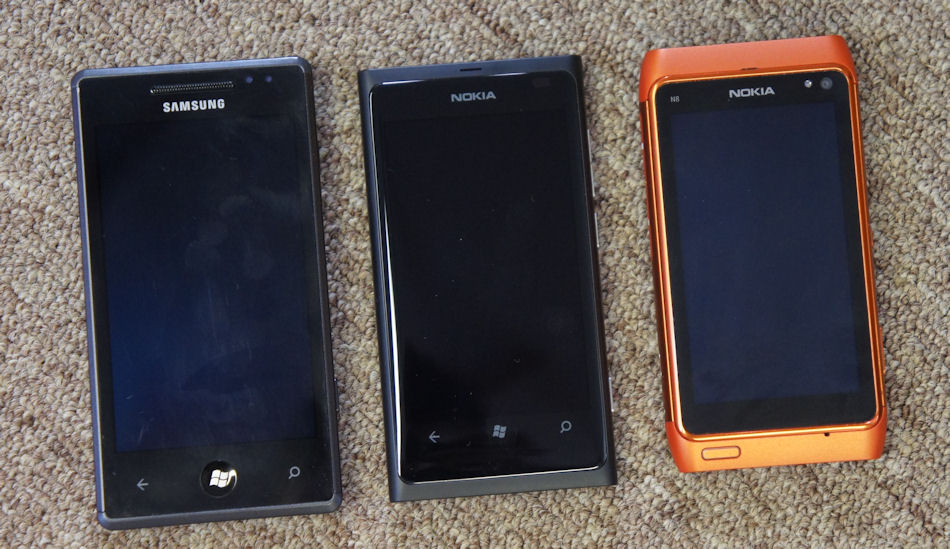
Samsung Omnia 7, Nokia Lumia 800 and Nokia N8 side by side
With a weight of 142g, the Lumia 800 has a reassuring feel of solidity, without feeling like a brick. However, it is a little heavier than comparable devices (Nokia N8 - 135g, Nokia C7 - 130g, HTC Radar - 137g, Samsung Omnia 7 - 138g).
Overall, the Lumia 800 is a well proportioned device, comfortably fitting into and operable with a single hand, a contrast to the recent trend for larger screen devices. The optimal screen size for a mobile device is open to debate, with personal preference being a key factor. I would suggest that the 3.5 to 4 inch range is becoming established as the best compromise between the competing factors, so it makes sense that Nokia's first Windows Phone device sits in the middle of this range.
Screen
The Lumia 800 has a 3.7 inch AMOLED display at the Windows Phone standard resolution of 800 x 480 pixels. The AMOLED screen is partnered with Nokia's ClearBlack Display technology, which rearranges the elements in the screen matrix to make the polarising layer more effective and reduce the air gaps, minimising in-screen refraction and reflections.
The underlying screen uses a Pentile matrix display technology, which is sometimes regarded as inferior to RGB. However, you would be very hard pressed to know what technology is being used with the naked eye. It's possible the sub-pixel arrangement may cause some strain when reading large amounts of small sized text, and looking through a magnifying glass, it is possible to pick up some white on black fringing, but I really don't think there's a significant overall impact here.

Magnified image of the screen showing black on white text; some fringing is visible.
The key characteristic of ClearBlack Display (in conjunction with AMOLED) is the accuracy with which darker colours, especially black, are presented. It's the lack of spill-over colour and the absence of any backlighting that impresses - it's the same kind of deep inky black that you only get on a totally moonless night in the middle of nowhere. For Windows Phone, this is especially effective as black is the dominant (default) background colour; much of the time, it's hard to see where the display ends and the bezel begins (hint: it's the bit that looks less black than the screen). Together with the vibrant colours, good outdoors visibility and (potentially) excellent energy performance characteristics that the AMOLED and CBD combination gives, this make for an alluring screen, that marks a high point for the device's hardware.
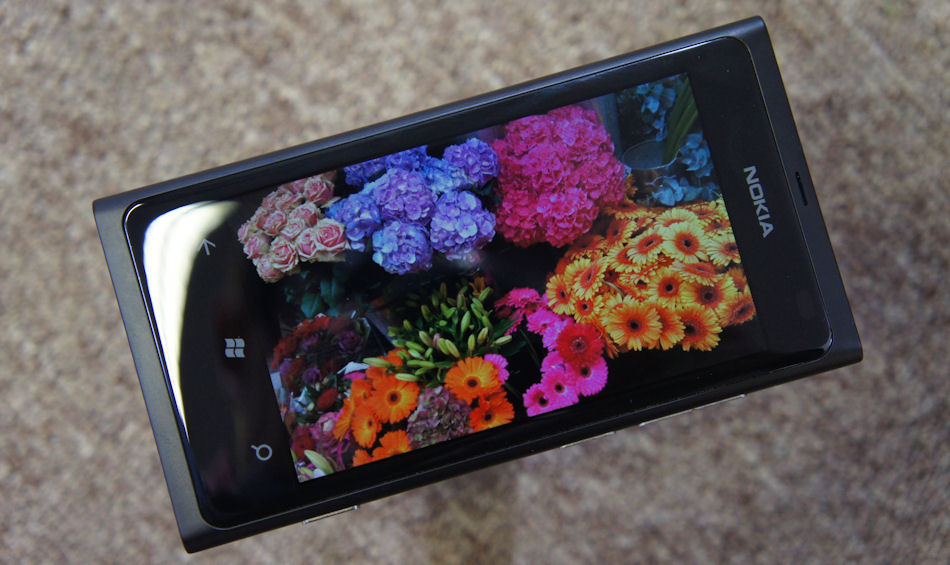
Nokia Lumia 800 AMOLED CBD display; note the vivid colours and inky blacks
Internals
Inside the unibody case, the Lumia 800 is powered by Qualcomm's Snapdragon MSM8255 SoC (System on a Chip). The processor is single core and is clocked at 1.4GHz; it's accompanied by an Adreno 205, for hardware graphics acceleration, and 512MB of RAM. This is faster than the first generation of Windows Phone devices (clocked at 1GHz), but not quite as fast as HTC's TITAN (clocked at 1.5GHz).
On paper, the specifications aren't that impressive, especially when compared to the multi-core Android devices, but (Top Trumps factor aside) what really matters is how quick the device feels. In day to day usage, the device never feels underpowered; the UI is impressively smooth and the only pauses come when opening large applications (e.g. Nokia Maps) or resuming non-fast switching apps (a software architecture limitation). Increasing the processor speed might keep specification hounds happy, but it is hard to see how it would improve the overall experience and would almost certainly be detrimental to battery life.
There's 16GB of onboard storage, which is sufficient for most users, but it would have been good to see a 32GB or 64GB variant. Windows Phone does give you easy access to 25GB of cloud storage space via SkyDrive, but that's more of an addendum than a replacement. The results of performance benchmarks suggest that Nokia has opted for NAND memory over the embedded microSD cards used in a number of the first generation of Windows Phone devices. This should give better day to day performance as it's better suited to the typical file operations of day to day usage.
In terms of connectivity, there's quad-band GSM, tri-band WCDMA (900/1900/2100) with Cat10 HSDPA (14.4Mbps) and Cat6 HSUPA (5.76Mbps), WiFi (b/g/n) and Bluetooth 2.1. On board sensors include dual microphones, GPS (location), 3D accelerometer, ambient light, magnetometer (compass) and proximity.
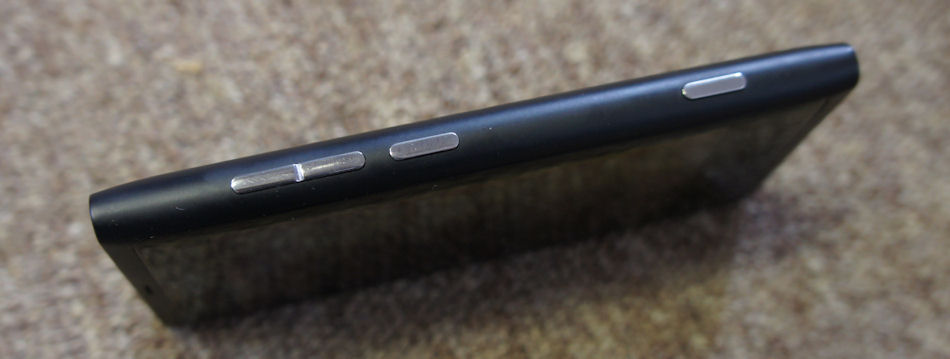
Right hand side of the Lumia 800: volume keys, lock/power key and camera capture key.
Battery life
The 1450mAh capacity of the Lumia 800's BV-5JW battery is decent, given the overall volume of the device. The official figures give talk time as 13 hours GSM / 9.5 hours WCDMA and standby time as 265 hours (GSM) / 335 hours (WCDMA), which is comparable with similar devices, but as normal you won't get anywhere near those figures in real world usage. The music playback figure of 55 hours is just about reasonable, assuming you run the device in flight mode at the same time.
In real world testing, under moderate to heavy usage, the battery lasted for just over 20 hours. However, everyone's 'normal' usage is different - the bottom line is that this is a 'charge once a day' device. This is in line with the best of the competing Windows Phone devices, broadly in line with the iPhone 4 and slightly ahead of most Android devices. However, it is significantly behind what Nokia's Symbian users will be used to.
As with most unibody designs, the battery is integral, so there's no easy way to switch the battery over. As with any rechargeable battery, capacity will decrease over time, but with an approximate rating of a thousand recharges before the capacity drops below 80%, it's unlikely to be an issue for most people.
We'll revisit the battery life topic in a later section of this review, once we've got some more real world testing under our belt and have fully assessed the impact of battery saving tricks, such as Window Phone's battery saver mode.
Hardware omissions
Looking at the specification list for the Lumia 800, there are some noteworthy omissions. The Windows Phone chassis specifications ensure a certain minimum standard, but a number of components are optional. Amongst these optional components is a gyroscope and front facing camera (FFC), neither of which are present on the Lumia 800.
The front facing camera is used for video calling, either over the cellular network or via an IP-based network (such as Skype). Currently, Windows Phone has very few applications using the FFC, although Skype, which was recently acquired by Microsoft, is expected to release an application that makes use of it before the end of the year. Thus its absence from the Lumia 800 is more about potential use, and therefore longevity of the device, than any current use case. Of the other second generation Windows Phone devices announced thus far, the HTC Radar and TITAN, and the Samsung Focus S and Focus Flash do have FFC, giving a potential point of differentiation for these devices. However, it is hard to see video conferencing as a mainstream use case.
A gyroscope provides additional sensitivity to motion measurements. Its main use case is in games where physical movement is used as a control mechanism, but is also sometimes used in augmented reality applications. However, it is purely additive to the existing accelerometer and magnetometer sensors. Thus its absence only slightly degrades the potential accuracy and sensitivity of movement information returned by the motion APIs. Currently, only the HTC TITAN and Samsung Focus S have a gyroscope, so it seems likely that most games will continue to be optimised for pure accelerometer based usage, so its absence from the Lumia 800 is a very minor concern.
Internet sharing ('tethering'/turning your phone into a WiFi hotspot) is not currently available on the Lumia 800. However, the Lumia 800 does have the necessary hardware support and Nokia says the functionality will be enabled in a software update.
Those coming from Nokia's Symbian platform may also like to take note of the absence of HDMI out, Near Field Communications and USB On The Go. None of these are currently supported by the Windows Phone 7.5 platform. This is scheduled to change in 2012, but that's obviously too late for the Lumia 800.

Be aware of the omissions and decide whether they're important for you
Hardware story
There's a good reason for the hardware omissions noted above. There's a very definite trade off between features and development time, one that is particularly acute in the case of the Lumia because of the strategic context surrounding the device.
This means that, to really understand the Lumia 800's hardware, it's necessary to understand the story behind it. This device is the first fruit of the partnership between Microsoft and Nokia that was announced back in February and finalised at the end of April. The first Nokia device was always going to be seen as a new chapter, so it was important for the credibility and aspirations of both companies to get a device out as quickly as possible.
That the Lumia 800 is hitting the shops 278 days (9 months) after the announcement of the partnership is a really impressive achievement. Typically, Nokia takes about two years to develop a phone - and even longer when the phone is the first in a new hardware platform, or the first of a new platform version. This sort of timeline is fairly standard for the mobile industry. However, it is possible to take some shortcuts - and this is exactly what Nokia has done - but it does come at a price.
The brain of a phone is its 'base board', a circuit board that contains various chipsets and related components (CPU, GPU, memory, DSPs, cellular radios, WiFi and Bluetooth chips, sensors and more). These components have to be integrated together and their capabilities made accessible to the software platform running on them. This is a time consuming and technical process, representing a significant part of the creation of any mobile phone. Typically such a base board, or hardware family, is used in multiple products, each of which will share the common base specification set. Each model will generally also require additional optimisation to work, as the precise hardware and design specification do vary (e.g. different screen component or camera module).

Nokia Lumia 800 in its slip case
Ten years ago, the only realistic way to create a smartphone was to build a hardware family from scratch. More recently, as the smartphone industry has exploded, it has become possible for companies to buy and use a pre-integrated hardware family. This has been encouraged by the chipset manufacturers (Qualcomm, ST Ericsson, Texas Instruments) and some of the platform providers (Microsoft, Google) who are all keen to ensure there are ready to go solutions that use their products.
Most of the big mobile manufacturers still create their own hardware families - this gives them greater control, gives more opportunity to differentiate their hardware and is cheaper at large scales. Smaller manufacturers will buy an off the shelf hardware family and differentiate through design and ancillary hardware. The advantage of buying off the shelf is greatly reduced development costs and a much faster time to market (because half the work has already been done).
In the case of the Lumia 800, Nokia, rather than develop its own Windows Phone hardware family from scratch, has opted to take a shortcut by using a Windows Phone base board/hardware family that has been developed by Compal. This has been matched with components that Nokia already had in development - CBD screen, 8 megapixel camera module and the unibody case design. All of these were in development long before the partnership with Microsoft was announced.
It's not quite a simple matter of plugging all the pieces together - the micro-engineering efforts involved in making sure everything fits inside the body, that there's no unexpected interference between components (radio and power-related, usually) and that it can withstand day to day shocks and bumps, are considerable.
This is, of course, a simplified explanation, but it helps explain most of the hardware omissions. Neither a gyroscope nor a front facing camera were part of the original Compal base board. Nor were HDMI out, FM transmitter or the Nokia-pioneered pentaband 3G; some, like NFC and LTE, were absent because they were not supported by the platform. Any of these features and their underlying components could have been added to the Lumia 800, but only at the cost of delaying the product.
The end result of the process outlined above was a dramatically shortened development timeline. Even with the shortcuts above, it's likely Nokia had to cut through internal processes and procedures, making this both an engineering and a managerial achievement.
In follow up products to the Lumia 800, we will see many of the omitted features added. In time, Nokia is also expected to develop its own Windows Phone hardware family - likely in time for the next major release of the platform.
But, for the first product, timing was all important. In my judgement, none of the omissions are likely to seriously impact upon the success of the product. For the majority of consumers, they fall into the 'nice to have' category, not the 'must have' category. By contrast, a delay, by even couple of months, of Nokia's first Windows Phone product could have been ruinous.

Pure Nokia on the oustide, but on the inside its a more complicated story...
Notes on the Nokia N9 and Nokia Lumia 800 comparison
In the early media coverage of the Lumia 800, a great deal of discussion has been devoted to the similarities between the MeeGo Harmattan-powered N9 and the Windows Phone-powered Lumia 800. The N9 received near universal adoration for its looks in the tech media, adding even greater allure to its 'forbidden fruit' status. The Lumia 800, while well received, was almost always described as having the same design as the N9. There was less immediate acclaim for the reductionist design.
It is absolutely true to say that the Lumia 800 uses the same body design and materials as the Nokia N9. However, the Lumia 800 is going to receive a much wider distribution and an enormous marketing campaign. This means, that, for the vast majority of people, the Lumia 800 will be the product that is most associated with the polycarbonate unibody design. The N9 may have been first, but it is the Lumia 800 that will benefit the most from the eye catching design.
The consequence of this is that the tech media may have underestimated the impact the Lumia 800 design will have. The design, especially when showcased in its three colours, draws the eye like no other device of the last few years. As a result, I would judge its impact as having the potential to be comparable with that of a new iPhone design in the public consciousness. This will not guarantee success in itself, but it does mean the Lumia 800 should stand out from the swathes of other smartphones hitting the market each month.
For the record, there are some important external design differences when comparing the Lumia 800 to the N9. It has a smaller screen (3.7 inches versus 3.9 inches), a consequence of the addition of three capacitive buttons at the bottom of the screen (the mandated back, start and search buttons of Windows Phone) and a camera capture button has been added on the lower right side of the device. Consequently the N9 has the more recutionist design, but the additional buttons on the Lumia arguably improve usability and accessibility.

Nokia N9, which shares a external design ancestry with the Nokia Lumia 800
Looking at the external design, it is easy to assume that the Lumia 800 is essentially the same phone as the N9, but running Windows Phone. However, appearances can be deceptive, because internally the devices are completely unrelated, utilising different chipsets and components. The micro-engineering required to place and the optimise the performance of all the components within the same case design will have required two completely separate efforts. It is this micro-engineering and integration process that takes up the vast majority of development time for a mobile device, which is why Nokia is rightly being lauded for producing a device just eight months after announcing its partnership with Microsoft.
In common with Nokia's Symbian devices, the N9 also has a more comprehensive and sophisticated technical specification base (NFC, pentaband 3G, more RAM and internal flash memory). For a technical-minded power user, the N9 remains an intriguing option, but it does come at a cost, both financially and in the long term sustainability of the platform.
Because of the market context of the two devices, a N9 versus Lumia 800 comparison has little relevance for consumers. However, it does offer an insight into Nokia's decision to shift in software strategy to Windows Phone. Despite the undoubted glories of the Nokia N9, I would suggest that the Lumia 800, even with its hardware handicap, offers the mainstream consumer a better and certainly a more accessible overall experience.
Hardware conclusion
With the Lumia 800 Nokia have delivered, in hardware terms, a standard Windows Phone device wrapped in an outstanding design. The beautiful design is burnished by the inclusion of a great camera module and first class screen, two of the most critical elements in any smartphone. Potential purchasers should be aware that there are some features not included, but in the vast majority of cases this will not have a meaningful impact on the purchase decision.
Power users may want to consider waiting for the next product iteration - inevitably a better specified Nokia device is on the way next year - that there's space for a 9 series product is quite obvious. However, there's always something better on the way... and power users are also generally early adopters for a good reason. Moreover, while there are some quibbles with the hardware, there's really no major negatives. It's more a case of being aware of the quibbles, so that you can make an informed decision.
In Windows Phone terms both the Samsung Focus S and the HTC TITAN offer superior specifications on paper, but they cost more and lack the grace and elegance of the Lumia 800's design. There's also the software side to consider; Nokia's entry to the Windows Phone market, as we shall see in subsequent review parts, marks the first time significant software differentiation might play a role in which Windows Phone device a consumer might choose.
Looking further afield the Lumia 800 is going to be compared to the iPhone 4S and Android devices like the Galaxy SII and the Motorola Droid RAZR. Here the specifications differences are more obvious, most notably in the processor, networking and screen areas. In a top trumps style specification comparison the Lumia 800 doesn't really match up to these high-end devices. However, it is hard to pick out any one hardware feature point that has a really significant universal impact on the overall product experience that might sway you one way or the other.
The design and styling of a phone is critical, but depends a great on personal preferences and opinion. The Lumia 800 has an advantage here - it's instantly recognisable, with a certain x-factor, marking it out as one of the best phone designs of the last few years. Amongst the style conscious it's very freshness, that sense of something new and different, could be a key point in its favour.
In all of this we should remember hardware is only part of the story; in the modern smartphone software is arguably the more important factor. But, in order to play in the software battle, you need great hardware. And that's something Nokia have undoubtedly delivered with the Lumia 800.
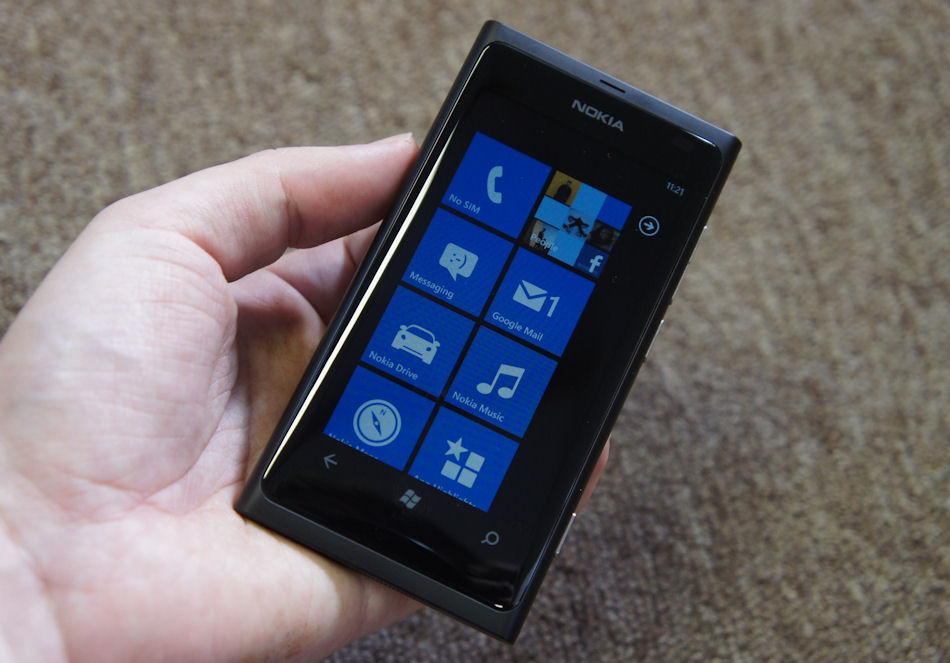
Nokia Lumia 800 showing Windows Phone start screen
Continuing coverage
In part 2 of our Nokia Lumia 800 review, we'll look at the software side on the device. Windows Phone will be a new experience for most consumers, so we aim to cover both the standard platform offerings and Nokia's additions.
If you've got any questions about this part of the review, or want to let us know whay we should be covering in subsequent parts of the review, please get in touch, or leave a comment below.
See Also
Nokia Lumia 800 first look video review
Reviewed by Rafe Blandford at
